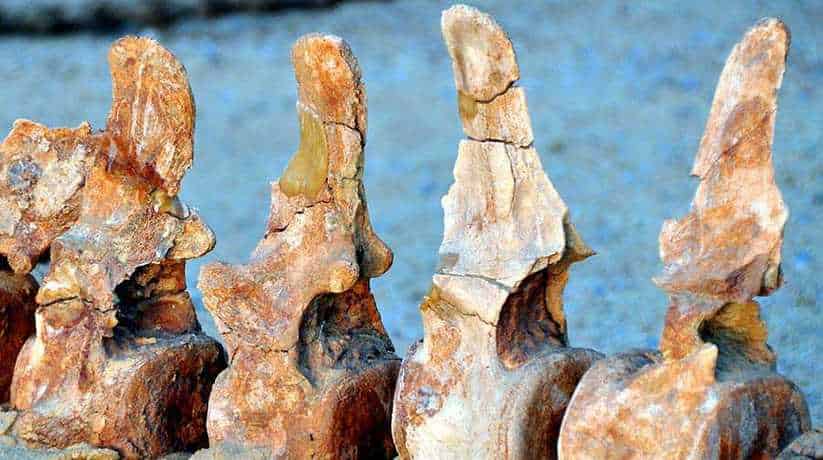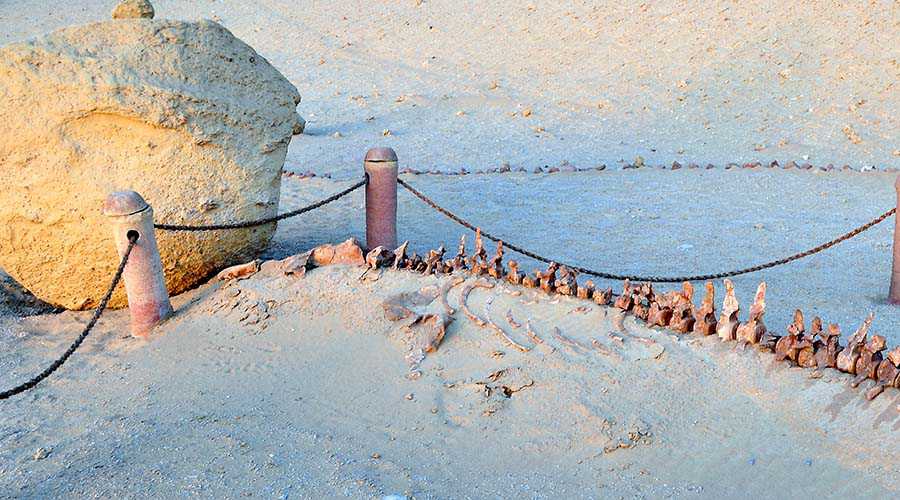Wadi El Hitan Fayoum Egypt tours, prices, booking, reviews
Wadi El Hitan Fayoum is an Arabic name which equivalent to Whales Valley in English. In fact, Wadi El Hitan is a pale ontological site situated in Fayoum, Egypt. It is about 150 km southwest of Cairo. Wadi El Hitan Fayoum designated a UNESCO World Heritage Site in July 2005. The valley has hundreds of fossils of some of the earliest forms of whale and the archaeoceti. (a now extinct sub-order of whales). The site reveals evidence for the explanation of one of the greatest mysteries. In fact, it is about the whales evolution. The emergence of the whale as an ocean-going mammal from a previous life as a land-based animal.
Wadi El Hitan has indeed hure number of fossils. In fact, they are accessible and sit in an attractive and protected landscape. That is why, Wadi El Hitan added by UNESCO to the list of protected World Heritage sites. In fact, the fossils which found at Wadi El Hitan Fayoum are not the. However, they feature great concentration in the area. Moreover, the degree of their preservation is really amazing. Some stomach contents indeed are intact. Moreover, the valley has fossils of other early animals such as sharks. Furthermore, the valley also has fossils of crocodiles, saw-fish, turtles and rays. The first fossil skeletons of whales discovered in the winter of 1902-3. For the next 80 years they attracted little interest. In fact, it was due to the difficulty of reaching the area.
Further details about Wadi El Hitan Fayoum:
In the 1980 interest in the site resumed as four wheel drive vehicles became more available. The remains display the typical streamlined body form of modern whales. They retain some of the primitive aspects of skull and tooth structure. The largest skeleton which found, reached up to 21 m in length. It is with well-developed five-fingered flippers on the forelimbs. The unexpected presence of hind legs, feet, and toes not known. Their form was serpentine and they were carnivorous. A few of these skeletal remains exposed but most shallowly buried in sediments. And then, slowly uncovered by erosion. In fact, Wadi El Hitan Fayoum provides evidences of millions of years of coastal marine life. Fossils are present in high numbers and often show excellent quality of preservation.
The most conspicuous fossils are the skeletons and bones of whales and sea cows. In fact, there are also several hundred fossils of these have which documented. The fossils of whales vary from single bones to entire skeletons. Many of partial skeletons are currently on display in the public part of the park. The two common whales are the large Basilosaurus, and the smaller (3 to 5 meter) Dorudon. At least two other species known from rarer remains. The whales have small hind limbs which not seen in modern whales. Moreover, they also have a powerful skull with teeth. In fact, they are like those of carnivorous land mammals. Other mammals represented by the skeletons of three species of sirenia or sea cows. Bones of the primitive elephant Moeritherium also recorded in Wadi El Hitan Fayoum.
More details about Wadi El Hitan Fayoum:
In fact, fossil reptiles represented by fossils of crocodiles and sea turtles. Furthermore, bones of sea snakes also recorded in Wadi El Hitan Fayoum. In fact, Wadi El Hitan Fayou has also many species of bony fish, sharks and rays. Larger fish fossils include the rostra and pegs of sawfish. A sawfish rostrum of 1.8 meters long laid out in the park. Fossil shells not common in the main whale-bearing rocks. In fact, they are common in other rocks. Moreover, many fallen rocks seen to be full of a wide variety of fossil shells. Disc-shaped nummulite fossils are common in places. A large log is also present in Wadi El Hitan park. In fact, the geology of Wadi El Hitan gives rise to the scenery. It is with wind and water erosion producing spectacular cliffs and buttes.
The rocks at Wadi El Hitan are all Middle to Late Eocene in age. Moreover, they comprise three main rock units. The Gehannam Formation comprises open marine mud stones. In fact, they are present on the flatter ground to the East of the public park. The rock unit which contains most of the whale fossils is the Birket Qarun Formation. This comprises yellowish open marine sandstone which form most of the cliffs and buttes. In fact, the monotony of these sandstone broken by a white layer. The layer full of well preserved animal burrows. A layer of black mud stone above that. When the cliffs of the Lake Qarun Formation followed to the East, they replaced by Gehannam. In fact, they replaced by mud stones formation indicating a change in water depth.
Further details about Wadi El Hitan Fayoum:
In fact, it was from shallower to deeper in that direction. The tops of the higher cliffs are within the Qasr El Sagha Formation. The formation comprises dark mud stones. It alternate with limestone full of shells and represents a lagoon environment. Wadi El Hitan is also the home to 15 species of desert plants and about 15 types of wild mammals. In fact, it include the north African jackal, red fox. and Egyptian mongoose. It also include African wildcat and Dorcas gazelle. Fennec foxes visit the camp site at night. Only about 1,000 visitors a year drive into Wadi El Hitan by 4WD. In fact, it is because the track unpaved.
Most of visitors to Wadi El Hitan are foreigners who usually camp in the valley on winter weekends. Wadi El Hitan is within the Wadi El Rayan which is also a Protected Area in Egypt. The same protection management plan restricts visitors. In fact, they restricted to prearrange guided tours along a prescribed trail. Sustainable tourism is the beginning to develop and grow in the area. The 4WD replaced by foot or camel treks. A part of Wadi El Hitan made into a tourist venue. That is why, walkways between the main fossils laid out and small shelters built. This public park now visited by tourist groups and a small camp site is present.
More details about Wadi El Hitan Fayoum:
The valley located behind a mountain, known as Garet Gohannam. In fact, Gara means hill or mountain and Garet Gohannam means the mountain of hell. In the light of the setting sun, the mountain seems ablaze with an eerie red light. The Egyptian government alleged that a pair of cars driven by Belgian diplomats entered a protected zone in this area. In fact, they and caused 325,000 US dollars worth of damage. It was in July 2007. The Belgium government said no damage caused by its diplomats. In fact, this issue remains unresolved.
[/vc_column_text][/vc_column][/vc_row]
















